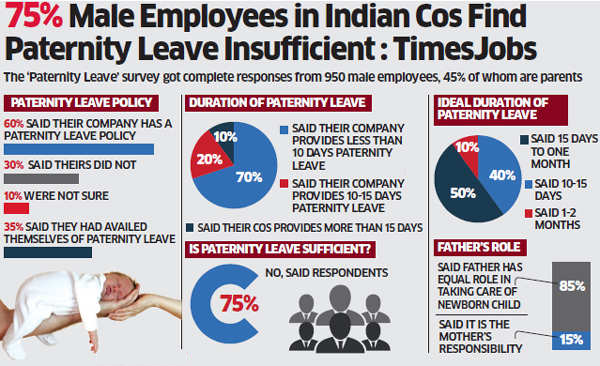Indian Society
Paternity Leave
This article is based on “Papa don’t leave” which was published in The Indian Express on 19/11/2020. It talks about the idea of paternity leave and the advantages associated with it.
Recently, the Captain of the Indian cricket team has asked for and was granted, paternity leave in the middle of a competitive Test series against Australia. Paternity leave is about giving fathers the right to take paid time off work following the birth (or adoption) of a child.
This is an important development in the context of gender discrimination at the workplace, but it will also have broader implications on the patriarchal mindset of Indian society.
Need For Paternity Leave
- Patriarchal Society: The culture of toxic masculinity that prevails in Indian society results in hesitancy and some amount of ridicule in doing what Indian men think is ‘women’s work’.
- Indian society continues to see men as the ‘breadwinner’ and women as the ‘homemaker’.
- Gender Gap in Labour Laws: There is no proper legislation for paternity benefits. The only provision that exists in India gives 15 days leave for the father, as opposed to a maximum of 26 weeks or 182 days for the mother.
- The number of days given to the mother can be partly justified by the physical healing the body needs after childbirth.
- However, the vast gap that exists between these two policies exposes the possible mindset that went into making them.
- The father need not stay at home as much as the mother must, as the mother is expected to carry the child-rearing responsibilities.
- In this manner, legal policies are reinforcing societal biases.
Note:
- The Maternity Benefit (Amendment) Act, 2017 allows for pregnant women to take leave for a total of 26 weeks out of which up to 8 weeks can be claimed before delivery.
- The woman is also supposed to get paid a benefit at the rate of her daily wage for three months before she goes on maternity leave.
- Dual Burden on Women: Making maternity leaves as the only parental leave option in a company doesn’t really bridge the gap between the domestic and the public; instead, it restricts the two even more strongly.
- The indirect implications are that women are supposed to not only juggle both work and home life but also return to home life for fulfilling the ‘nurturing’ role.
- The time-use survey report released last month by the National Sample Survey Office (NSSO) shows that Indian women spend nearly four hours more on unpaid work than men, with grim consequences for women’s participation in the workforce.
Changing Trends
- Suo-Moto Action: Several private companies, too, offer paternity leave, without the prodding of legislation. For example, last year, Zomato rolled out 26 weeks of paid paternity leave for employees who become new fathers.
- International Scenario: In Britain, Sweden and Norway, parents are granted about a year of paid parental leave to tend to their newborns during that particularly crucial and difficult period.
- Impact of Covid-19 Pandemic: By integrating the home and the workplace (Work from Home scenario), the Covid-19 pandemic has underlined the extent to which the invisible labour is done by women at home.
- Indian Scenario: Four years ago, the Ministry of women and child development had pitched for the idea of legislating for paternity leave in the organised sector.
Advantages of Paternity Leave
- Debunking Patriarchy: Paternity leave – and especially longer leaves of several weeks or months – can promote parent-child bonding, improve outcomes for children, and even increase gender equity at home and at the workplace.
- Further, when fathers are more engaged in raising children, they may become more aware of the challenges associated with it. This, in turn, may lead to a relationship which is compassionate and understanding.
- This could be one of the first steps towards achieving a more egalitarian view in society and debunk patriarchy.
- Check Declining Women Labour Force Participation: Due to the societal sexism, women are often missing out on these critical years of work once being pressured into staying home with their children.
- The years that women generally have children, between the ages of 25 and 35, are when people tend to begin making serious progress in their careers.
- Therefore, if paternity leaves are normalised, and men actively start taking up the responsibility of child care, would check the declining women labour force participation rate.
Conclusion
The battle against this deep-grained sexist skew in work and labour is a long haul. But the idea of official paternity leave — if endorsed by governments and private companies — takes a minimum first step in acknowledging that parenting and childcare is the shared responsibility of men and women.
|
Drishti Mains Question Paternity leave is an idea whose time has come, for both Indian men and women. Discuss. |
This editorial is based on “Fragile ceasefire: on Armenia–Azerbaijan clashes” which was published in The Hindu on November 18th, 2020. Now watch this on our Youtube channel.





